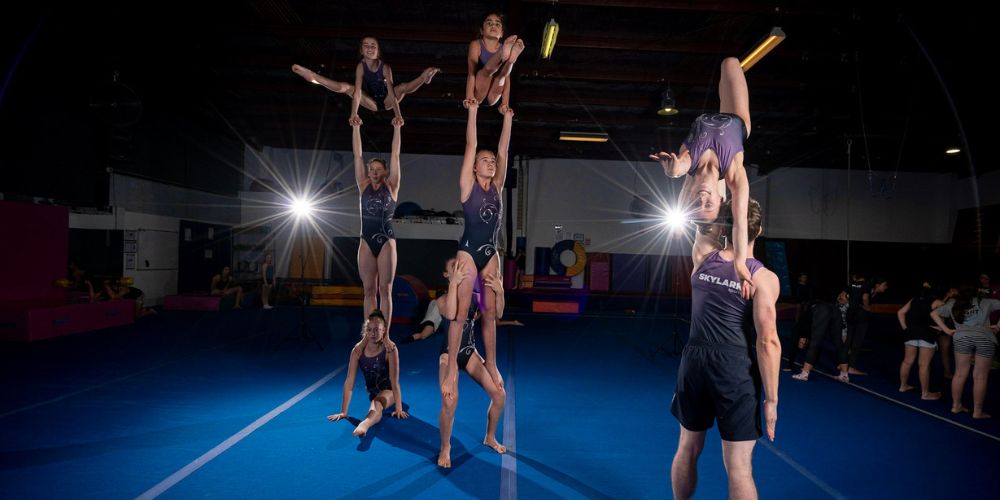Gymnastics, like any other sport, is all about improvement and development. The journey begins with small gymnasts' first unsteady steps on the mat and continues through carefully planned stages that challenge and develop their skills. These levels serve as stepping stones, encouraging gymnasts along their growth path and laying a solid foundation of strength, flexibility, and technique.
Have you ever watched gymnasts execute fantastic flips, spins, and gravity-defying routines and thought, "How do they reach such incredible levels?" Well, you're going to find out! Today, we're delving headlong into the intriguing realm of gymnastics levels to solve the enigma of the many phases gymnasts pass through on their way to greatness.
So prepare to tumble, flip, and vault your way through this blog as we explore the mysteries of the numerous levels that comprise this gravity-defying sport.
Let's hop onto the balance beam and get started!
What Do "Levels" Mean in Gymnastics?
In the fast-paced world of gymnastics, "levels" are a crucial notion that serves as the sport's foundation. Levels indicate the many stages or tiers of gymnastics training and competition. They give gymnasts a structured framework to improve and develop their talents systematically.
Consider levels to be milestones or checkpoints throughout a gymnast's path. Gymnasts move from one level to the next as they gain new powers, strength, and technique, unlocking increasingly difficult routines and talents. Each level serves as a stepping stone, creating the groundwork for the talents necessary at subsequent levels.
The introduction of levels in Australian gymnastics serves numerous goals. They guarantee that gymnasts learn the required skills and techniques at each step, establishing a firm foundation of basics. This progressive approach stresses safety and lowers the danger of injury, allowing gymnasts to grow and thrive in an organized and regulated environment.
Levels establish a uniform framework among Australian gymnastics programs and events. Gymnastics Australia, the regulatory organization, establishes particular criteria for each level, including skill levels, routine compositions, and age divisions. This promotes judging fairness and consistency, allowing gymnasts from different areas and clubs to compete equally.

Different Levels of Gymnastics
Gymnasts go through several levels in gymnastics as they increase their skills and talents. These levels are intended to offer gymnasts a systematic framework for training and competition, helping them to improve and master more difficult routines steadily. While the particular titles and requirements may alter significantly according to the gymnastics organization or nation, below is a broad summary of the many gymnastics levels:
Beginner Levels
BabyGym
The BabyGym program encourages newborns' and young children's physical and cognitive growth through structured play and movement exercises. Although some program versions may stretch to children as old as 5, its traditional target audience is infants and toddlers ages 0 to 2.
The main goal of the BabyGym program is to give infants a secure and engaging setting in which they may explore and refine their motor abilities, sensory perception, and body awareness. The exercises during BabyGym sessions are created to help newborns reach their normal developmental goals while promoting flexibility, strength, balance, and coordination.
Kindergym
For kids aged 2 to 5, this level emphasizes the fundamentals of movement in a joyful and enjoyable setting. It uses age-appropriate exercises, games, and equipment to promote the development of fundamental motor skills, coordination, balance, and spatial awareness.
Gymnastics for All
In Australia, a recreational gymnastics program called Gymnastics for All (GfA) strives to give individuals of all ages and skill levels a chance to participate in gymnastics activities. For those looking to study and advance their gymnastics abilities in a non-competitive setting, the GfA levels, which range from Level 1 to Level 10, provide a systematic progression.
The GfA levels offer an adaptable and inclusive framework that allows people to advance at their rate. Children and adults of all ages and ability levels can participate in the program, which allows them to explore many facets of gymnastics according to their interests and skills. Without the stress of competition, it encourages physical health, self-assurance, inventiveness, and pleasure in the activity.
Here is more detailed information on the GfA levels:
GfA Level 1-3:
These levels emphasize the fundamentals of gymnastics to the participants. Participants learn the fundamentals of these talents on various equipment, including floor exercises, balancing beams, uneven bars, vaults, and trampolines. The focus is enhancing body control, flexibility, strength, and coordination.
GfA Level 4-6:
These levels add to the knowledge gained in the preceding levels while introducing more difficult features. Participants keep improving their technique while increasing their strength and flexibility. On the apparatuses, they could begin learning more advanced techniques and combinations.
GfA Level 7-10:
These levels are intended for people who have established a solid gymnastics foundation. Higher degrees of strength, flexibility, and coordination are required as they concentrate on complex movements and combinations on the apparatuses. Competitors can exhibit high expertise and mastery in gymnastics at these levels.
Competitive Levels
The hard and highly skilled discipline of competitive gymnastics requires stamina, flexibility, agility, elegance, and accuracy. With its dazzling demonstrations of agility and artistry, it is a sport that has captured the attention of spectators worldwide.
Junior Levels (Levels 1-5)
Young gymnasts, often under 12, with talent and dedication to competitive gymnastics should compete at these levels. The junior levels emphasize the mastering of core skills and skill growth. Gymnasts in these levels must learn routines on the vault, uneven bars, balancing beam, and floor exercises on each piece of equipment. The gymnasts must meet preset standards as part of the scheduled routines. As they go through the levels, young gymnasts acquire experience and establish a strong foundation in the sport.
Senior Levels (Level 6-10)
The senior levels are for more experienced gymnasts who want to compete at harder degrees of difficulty while honing their abilities. Gymnasts continue to execute required routines in Levels 6 through 8, which are identical to the junior levels but feature more difficult skills and combinations. Additionally, some prerequisites must be satisfied for certain procedures. Gymnasts go to optional routines in Levels 9–10, giving them greater freedom to highlight their talents and personal qualities. Senior-level gymnasts strive to show technical mastery, artistry, and performance difficulty.
Other Gymnastics Disciplines
Rhythmic Gymnastics
With the use of numerous portable equipment, the discipline of rhythmic gymnastics blends aspects of ballet, dance, and gymnastics. Gymnasts utilize rope, hoops, balls, clubs, and ribbons to accomplish routines. There are levels from 1 to 10 in the rhythmic gymnastics level system. Gymnasts must meet specified standards and exhibit certain abilities for each level. Gymnasts advance through the levels, increasing the difficulty and complexity of their routines, which incorporate graceful body movements, equipment control, and musical synchronization.
Trampoline Gymnastics
Acrobatic abilities and combinations are the main focus of the sport known as trampoline gymnastics. Height, spatial awareness, and fine body control are all required. The level system for trampoline gymnastics ranges from 1 to 10. As they go through increasingly tough stages, athletes pick up new abilities, including somersaults, twists, and combos. Trampoline gymnasts can advance in their competitive careers and develop their talents along a systematic path according to the level system.
Aerobic Gymnastics
Aerobic gymnastics mixes exercise with strength, flexibility, and choreography to produce exciting routines. It entails making high-intensity moves to music while jumping, kicking, leaping, and lifting. Aerobic gymnastics has a different level structure than artistic and rhythmic gymnastics. As an alternative, there are many divisions and age groups for competition. Criteria, including difficulty, execution, artistic interpretation, and overall performance, are used to judge gymnasts. Athletes can display their physical prowess, artistic expression, and stage presence through aerobic gymnastics.
Are Gymnastic Levels Important?
Yes, levels in gymnastics are significant in the sport. They have several uses and offer a range of advantages to gymnasts and the sport at large. The following are some arguments in favour of gymnastic levels:
Skill Progression
Gymnasts can advance and hone their talents along a systematic course provided by gymnastic levels. Each level builds on the preceding levels' foundation by introducing new components, combinations, and difficulties. The development ensures a logical and secure increase in difficulty while allowing gymnasts to learn abilities quickly.
Goal Setting and Achievement
Gymnasts have distinct objectives to strive for, thanks to levels. Gymnasts may set specific goals as they go through the stages to master new abilities, enhance their technique, and boost their overall performance. Gymnasts can be highly motivated by the achievement and satisfaction of meeting and exceeding level criteria.
Fair Competition
Gymnastic levels provide a level playing field during competitions. Competitions may be set up such that athletes of equal ability levels compete fairly by classifying gymnasts into different categories depending on their experience and skill level. This enables gymnasts to compete against athletes of a similar calibre, encouraging healthy competition and offering chances for success and development.
Monitoring of Progress and Safety
In addition to being vital for guaranteeing gymnast safety, levels. Thanks to the courses ' progressive design, gymnasts acquire the required strength, flexibility, and technique to complete increasingly advanced skills safely. Level criteria can be a reference for coaches and judges as they track a gymnast's development and offer pertinent criticism and direction.
Talent Identification and Development
Gymnastic levels may also be used to spot gifted gymnasts who can improve their craft. Level accomplishments can be used to gauge a gymnast's ability and potential by coaches, clubs, and national governing bodies, opening doors for additional training and progression in elite or competitive routes.
Frequently Asked Questions
Can adults participate in gymnastics?
Yes, gymnastics is open to adults as well. Numerous gymnastics clubs provide adult lessons or leisure activities catered to adults of varying ability levels. These lessons may be a terrific way to develop your flexibility, physical fitness, and gymnastics abilities in a friendly setting.
How long does it take to become an elite gymnast?
The time it takes to develop into a top-level gymnast varies widely and is influenced by several variables, including inherent talent, training intensity, commitment, and age at which training starts. Achieving a top-level often requires years of constant and focused training, frequently beginning at a young age. Elite gymnastics involves a considerable amount of dedication, effort, and sacrifice.
Is gymnastics only for females?
No, gymnastics is not just a sport for women. Due to the prominence of women's artistic gymnastics, the sport is frequently associated with female gymnasts. However, there are also male artistic gymnastics, in addition to other disciplines like rhythmic gymnastics and trampoline gymnastics, available to both sexes.
If I'm not flexible, can I still perform gymnastics?
Yes, with the right training, flexibility may be enhanced. Stretching and flexibility drills are specialized in gymnastics training to increase the range of motion. Gymnastics allows people to engage even if they are not naturally flexible and gradually work on becoming more flexible.
Conclusion
Gymnastics is a sport that caters to people of all ages and abilities. It offers physical development, skill progression, goal setting, and a sense of accomplishment. Gymnastics promotes strength, flexibility, coordination, discipline, and creativity through various disciplines such as artistic, rhythmic, and trampoline. Gymnastics levels are important for structuring the sport, ensuring fair competition, monitoring progress, and fostering skill development. Regardless of the discipline or level, gymnastics offers a rewarding experience that promotes physical fitness, personal growth, and a lifelong love for movement and athleticism.
Remember to consult with qualified coaches and gymnastics organizations to find the best program and level that suits your interests, aspirations, and individual needs. Enjoy the journey, embrace the challenges, and have fun exploring the world of gymnastics!

